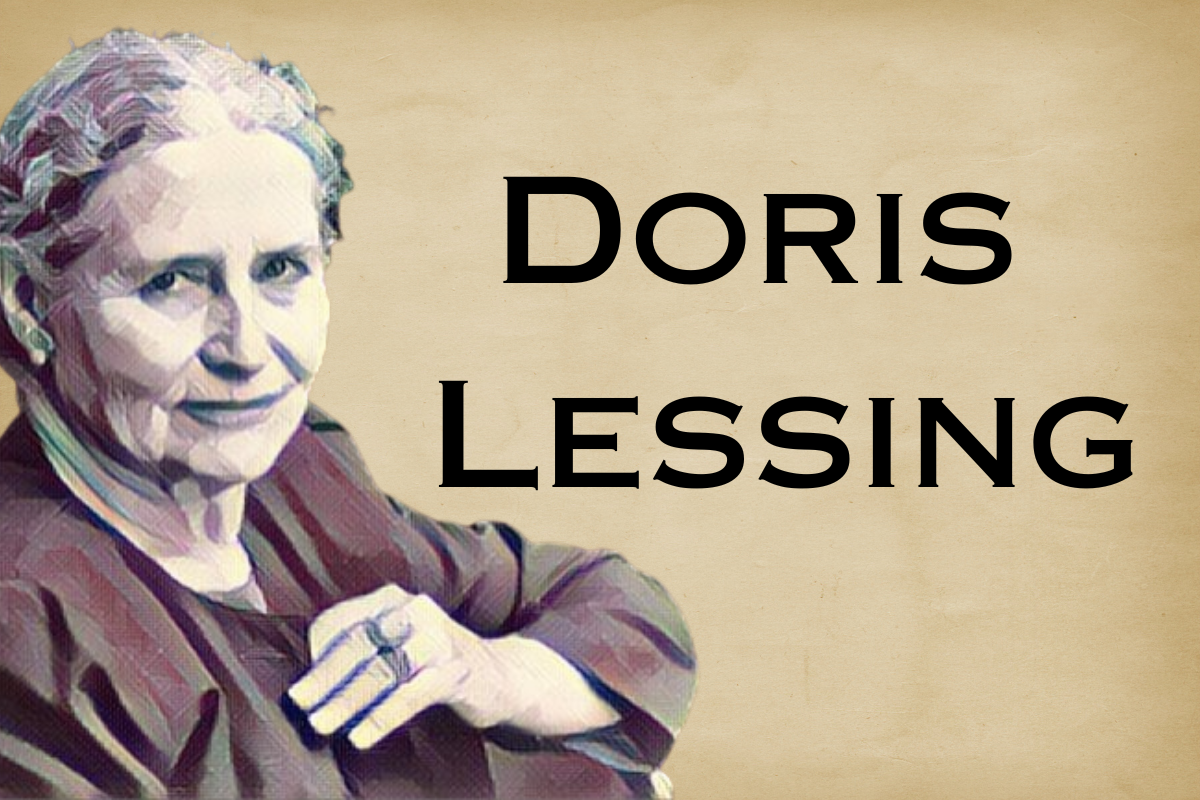Doris Lessing (1919-2013) was a renowned British Zimbabwean author and recipient of the Nobel Prize in Literature. Throughout her extensive career, which spanned more than seven decades, she excelled in various literary genres, including novels, short stories, plays, and essays. Lessing’s writing delved into profound subjects such as identity, politics, and societal matters. These themes were greatly influenced by her upbringing in colonial Africa and her subsequent life in England.

Family Background of Doris Lessing
Doris Lessing, originally named Doris May Tayler, was born on October 22, 1919, in Kermanshah, Persia (now Iran). Her family had a diverse background consisting of British heritage. Her father, Alfred, worked at the Imperial Bank of Persia which is why she was born there. This connection to the British Empire’s colonial presence in Persia would later shape her viewpoint on social and political matters.
At the age of five, Doris and her family relocated to Southern Rhodesia (now Zimbabwe) in 1925. This move marked the start of her enduring bond with Africa. Her father’s attempt at farming in this new land proved largely unsuccessful, leading to significant financial hardship for the family.
Doris’s family encountered numerous challenges during World War II, and as a result, her parents’ marriage underwent significant strain. This turbulent period deeply impacted her and played a pivotal role in shaping her writing, which often explores profound insights into the human condition and the dynamics of societal transformation.
When Doris was 19 years old, she married her first husband Frank Wisdom. They had two children together, but unfortunately, their marriage ended in divorce in 1943. These early experiences of being a young mother and facing the challenges of being a writer influenced some of her initial works. She died on November 17, 2013.
Writing Style of Doris Lessing
Doris Lessing’s writing style underwent significant changes and development throughout her career. Several key elements define her distinctive style:
- Varied Genre: Doris Lessing was a writer who had the ability to explore and excel in different genres. She delved into novels, short stories, essays, and even science fiction. This versatility allowed her to adapt her writing style based on the unique requirements of each genre she tackled.
- Social Realism: In her earlier works, specifically in The Grass Is Singing and the Children of Violence series, Lessing utilized a style of social realism. These novels depicted the harsh realities of colonial Africa and explored the challenges faced by women, employing a direct and unfiltered narrative approach.
- Psychological Depth: Lessing’s writing was characterized by its exploration of the deep psychology of her characters. With a keen understanding of human nature, she delved into complex emotional and psychological landscapes through her vividly drawn characters.
- Narrative Experimentation: Doris Lessing’s novel, The Golden Notebook, showcases her narrative experimentation through the use of multiple perspectives and fragmented storytelling. This technique effectively mirrors the protagonist’s fragmented life.
- Political and Philosophical Themes: Through her writing, she delved into various political and philosophical topics, drawing from her personal encounters with communism, activism, and the pursuit of utopian concepts. These themes seamlessly intertwined within the stories she crafted, inviting readers to contemplate and discuss wider socio-political matters.
- Diverse Settings: Lessing’s writing takes readers on a journey through diverse settings, encompassing everything from her experiences in Africa to the imaginative realms of speculative fiction found in works such as Canopus in Argos. Her talent for creating immersive environments truly shines as she transports readers into these different worlds.
- Character-Driven: Focused on the depth of character, her novels delved into complex and multi-dimensional individuals. By placing emphasis on the growth of these characters, she skillfully explored themes of human relationships and the influence of society on individuals.
- Clarity and Precision: Even as she played with narrative techniques, Lessing’s writing always maintained clarity and precision. Her prose was characterized by its sharp and concise language, which allowed her ideas and themes to be understood by readers of all backgrounds.
Themes of Doris Lessing
Doris Lessing delved into a vast array of themes during her prolific writing career. Some notable themes in her books include:
- Feminism and Gender Roles: Lessing’s novels often explore the intricacies of women’s lives and the obstacles they encounter in a male-dominated society, showcasing her feminist viewpoint. One of her most renowned works, The Golden Notebook, stands as a significant contribution to feminist literature. It delves into the experiences and struggles of its protagonist, Anna Wulf, offering an insightful examination of both her internal thoughts and her external reality.
- Social and Political Change: Lessing’s writing often reflects the turbulent social and political landscapes of the 20th century. Her novel The Grass Is Singing explores racial tensions and colonialism in Southern Africa, while The Children of Violence series traces the political and social evolution of a character against the backdrop of global events.
- Psychology and Consciousness: Psychology and the study of consciousness were topics that greatly captivated Lessing. In her science fiction series titled Canopus in Argos: Archives, she delves into the complexities of human psychology, exploring themes such as consciousness, societal evolution, and the overall human condition.
- Individual vs. Society: The conflict between personal desires and societal conventions is a common theme in Lessing’s writing. Her characters often face the challenge of defying societal expectations and pursuing their own unique paths in life.
- Motherhood and Family: Lessing delved into the intricate dynamics of familial relationships, specifically exploring the bond between mothers and their children. Her novel The Fifth Child presents a compelling depiction of a mother’s challenge to navigate and understand a child who is markedly distinct from others.
- Spirituality and Mysticism: Lessing’s curiosity about spirituality and mysticism is apparent in works such as The Sirian Experiments. These novels explore profound and enigmatic themes, challenging our understanding of human experience.
- Alienation and Isolation: A recurring theme in her works is the struggle with alienation and isolation experienced by her characters. These feelings mirror the widespread sense of disconnection prevalent in contemporary society.
- War and Conflict: Lessing had firsthand experience of World War II, which deeply influenced her writing. The effects of war and conflict on individuals and society are recurring themes throughout her works.
Doris Lessing’s skill in addressing such varied themes with profound insight has cemented her enduring presence in the literary canon.
Recommended: Surrealism in Literature | Characteristics, Writers, and Examples
Notable Works of Doris Lessing
Here are some of her famous books of Doris Lessing:
1. The Golden Notebook (1962): This complex and groundbreaking novel follows the life of its main character, Anna Wulf. It explores profound themes such as feminism, politics, and personal identity.
2. Children of Violence Series: This series comprises five novels, including
-
Martha Quest (1952)
-
A Proper Marriage (1954)
-
A Ripple from the Storm (1958)
-
Landlocked (1965)
-
The Four-Gated City (1969)
The series follows the life of Martha Quest, a young woman in colonial Africa. Later in London, she grapples with personal and societal changes.
3. The Grass is Singing (1950): This early novel by Lessing delves into the intricate dynamics between colonizers and the colonized in Southern Rhodesia, now known as Zimbabwe. It tackles themes of racial unrest and the profound isolation experienced by its characters.
4. Briefing for a Descent into Hell (1971): This is a captivating novel that delves into the worlds of psychology and metaphysics. It takes readers on an intriguing journey alongside Charles Watkins. He is the mentally unstable protagonist, through a surreal and introspective narrative.
5. Memoirs of a Survivor (1974): This dystopian novel is set in a bleak future where society is disintegrating. It’s a thought-provoking exploration of human survival and adaptation in the face of societal collapse.
6. Shikasta (1979): This science fiction novel is framed as a report from the higher extraterrestrial civilization, Canopus, about planet Shikasta, symbolizing Earth. The book delves into the history and evolution of Shikasta. It explores how external cosmic forces have influenced the planet, resulting in significant historical events and obstacles.
Other notable works are Through the Tunnel (1955), A Sunrise on the Veld (1975), A Woman on a Roof (1963), Adore A Novella (2013), African Laughter (1992), and The Good Terrorist (1985).
Famous Quotes of Doris Lessing
Here are some of her famous quotes:
- “That is what learning is. You suddenly understand something you’ve understood all your life but in a new way.” – The Golden Notebook
- “We are all creatures of the stars.” – Shikasta
- “In university, they don’t tell you that the greater part of the law is learning to tolerate fools.” – The Good Terrorist
- “Think wrongly, if you please, but in all cases, think for yourself.” – The Golden Notebook
- “Whatever you’re meant to do, do it now. The conditions are always impossible.” – The Golden Notebook
- “It’s very difficult to matter. It’s very difficult to be clear about who you are.” – The Golden Notebook
Doris Lessing was awarded the Nobel Prize in Literature in 2007 for her skepticism, fire, and visionary power, becoming one of the few British authors to receive this prestigious honor. Her unflinching and thought-provoking storytelling left an indelible mark on 20th-century literature, earning her widespread acclaim and recognition.
Recommended: Harry Potter and the Sorcerer’s Stone | Summary, Characters and Themes



